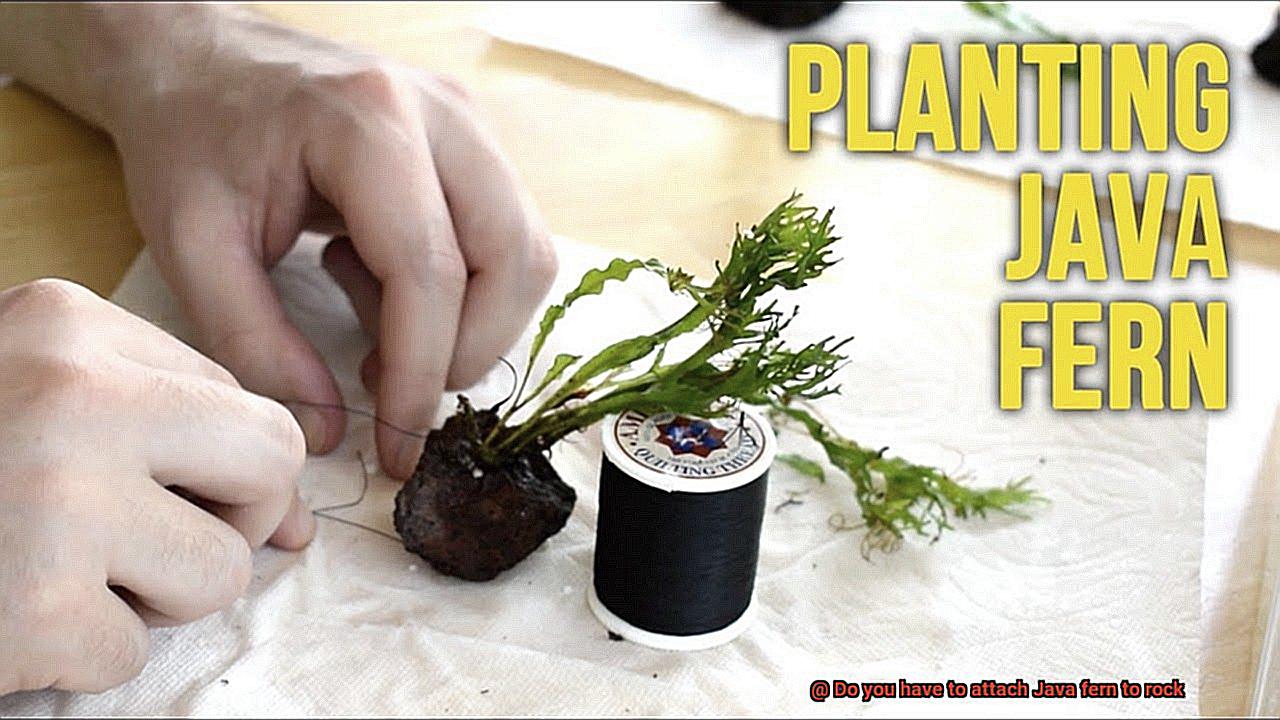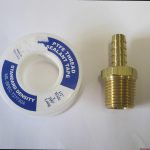Are you an aquarium aficionado or a fan of aquatic greenery? If so, then you’ve probably heard about the Java fern. This hardy and breathtakingly beautiful plant is a favorite among aquarists. But here’s the burning question: Do you really have to attach it to a rock? Let’s find out.
In this blog post, we’ll dive into the captivating world of Java fern and explore whether attaching it to a rock is a must-do or just an optional gardening practice. We’ll uncover the perks of doing so, walk you through the attachment process, and dish out some handy tips to ensure your Java fern flourishes in its new aquatic abode.
So, get ready for an adventure that will elevate the allure of your underwater oasis and create a lush haven for your aquatic pals. Let’s jump right in.
Benefits of Rock-Attached Java Fern:
Contents
While it’s true that you can let your Java fern roam freely in your aquarium, fastening it to a rock brings several advantages. First off, rocks provide stability, preventing your fern from drifting away or being disturbed by water currents—perfect if you have active fish or other lively tank dwellers.
Moreover, attaching your Java fern to a rock mimics its natural habitat. In the wild, these plants cling onto rocks, logs, and riverbanks with gusto. By recreating this environment, you offer familiarity and help your fern thrive like never before.
How to Attach Your Fern:
Attaching Java fern to a rock is as easy as pie. Begin by choosing an aquarium-safe rock with a rough texture that allows the plant’s rhizome (the thick stem from which leaves sprout) to grip firmly. Give the rock a thorough cleaning to remove any dirt or debris.
Next up, take your beloved Java fern and locate its rhizome. Using a thin thread or fishing line, gently tie the rhizome to your chosen rock. Remember, don’t tie it too tightly—let your fern breathe and avoid any harm.
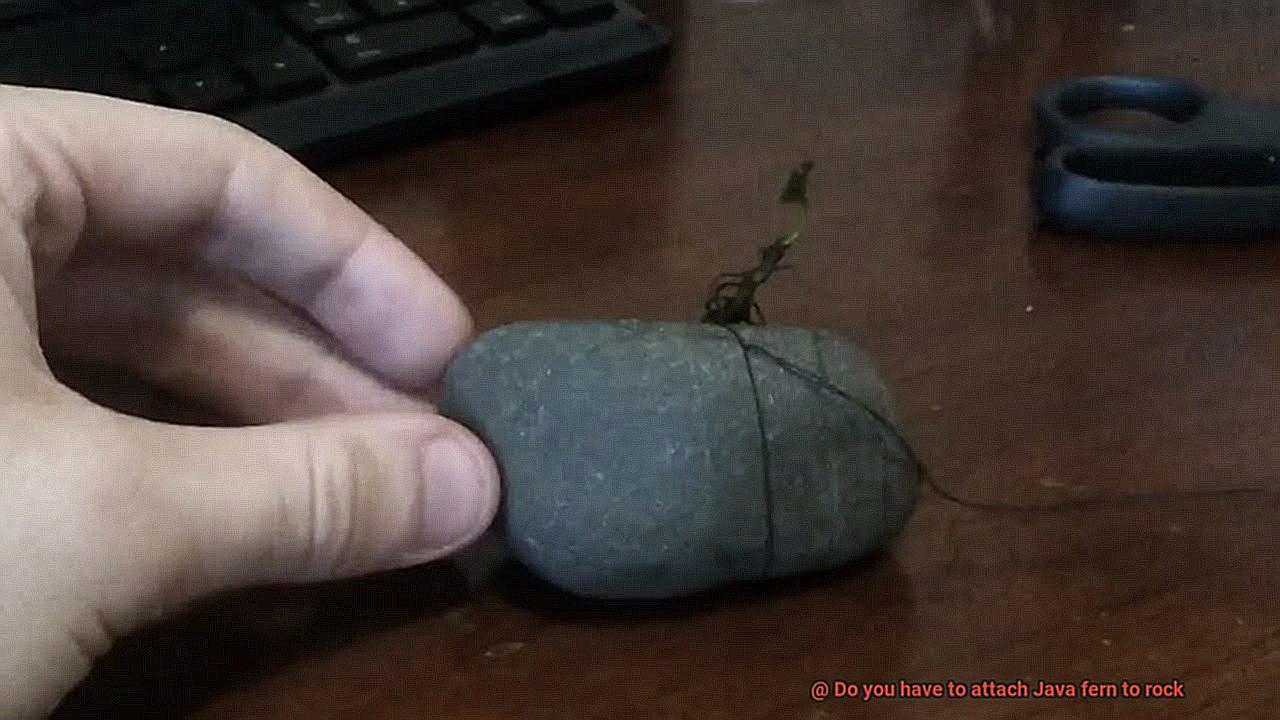
What is Java Fern?
Aquariums are not just about the fish; they are about creating a captivating and natural underwater world. One plant that can add both aesthetic appeal and functionality to your aquarium is Java Fern (Microsorum pteropus).
Native to Southeast Asia, this popular aquatic plant is known for its unique appearance and hardy nature. Whether you’re a seasoned aquarist or just starting out, Java Fern is a fantastic choice that can elevate the beauty of any aquarium.
Distinctive Leaf Structure:
Java Fern’s long, narrow leaves are a sight to behold. With their leathery texture and slightly crinkled or wavy appearance, they resemble the delicate fronds of a fern. These leaves can grow impressively large, reaching lengths of up to 12 inches (30 centimeters). The vibrant green color adds a refreshing touch to any aquascape.
Versatile Growth Pattern:
Unlike many other aquatic plants that require planting in the substrate, Java Fern is an epiphyte. This means it can attach itself to various surfaces such as rocks, driftwood, or even the glass walls of an aquarium. Its unique rhizome structure allows it to anchor itself securely, providing endless possibilities for placement within your tank. You can create stunning underwater landscapes by attaching Java Fern to rocks or driftwood, or use it as a background plant by attaching it directly to the back wall of the tank.
Adaptability and Resilience:
Java Fern is renowned for its adaptability and resilience, making it an excellent choice for aquarium setups with varying water parameters. It can thrive in both soft and hard water conditions, adjusting to different pH levels. Additionally, Java Fern can tolerate low to moderate lighting conditions, making it ideal for tanks with limited or indirect light sources. Its hardy nature ensures its survival even in less favorable conditions.
Low-Maintenance Beauty:
One of the best things about Java Fern is its low maintenance requirements. It doesn’t demand nutrient-rich substrates or frequent fertilization. However, providing adequate lighting and supplementing with liquid fertilizers can promote healthier and more robust growth. Regular pruning of damaged or discolored leaves is also recommended to maintain the plant’s overall appearance. With minimal effort, you can enjoy the beauty of Java Fern in your aquarium for years to come.
Does Java Fern Need to be Attached to Rock?
Let’s dive right in and explore the captivating pros of attaching Java Fern to a rock:
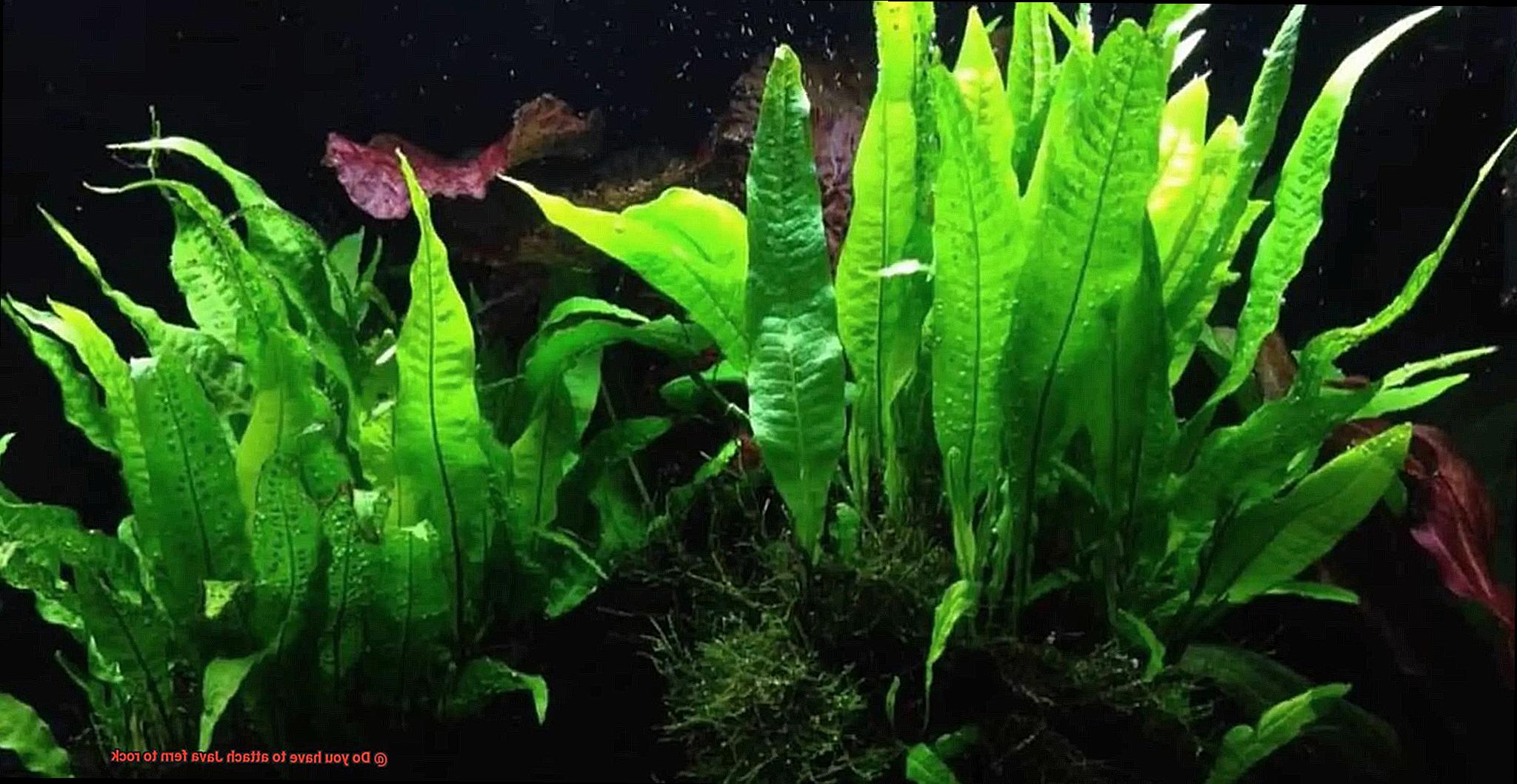
- Aesthetic Appeal: Picture this – a natural masterpiece unfolding in your aquarium. By attaching Java Fern to a rock, you create a mesmerizing display that adds depth and texture to your tank. It’s like inviting Mother Nature herself into your aquatic haven.
- Secure Attachment: Say goodbye to the anxiety of floating ferns. With the aid of fishing line or specially designed aquarium glue, you can ensure a steadfast attachment. No more worries about your precious Java Fern drifting away or being disrupted by mischievous tankmates.
Let’s now venture into the depths of the cons:
- Growth Limitation: Ah, the delicate dance between aesthetics and flourishing flora. Java Fern, being a slow grower, may have its growth potential curtailed if attached to a rock. If you yearn for a more organic look with freely floating or ground-planted ferns, perhaps skipping the attachment is the way to go.
- Interactions with Tankmates: Beware of unforeseen disturbances in your underwater ecosystem. If you have other plants or creatures in your tank that might interfere with or uproot your Java Fern, it might be wiser to let it roam free. After all, harmony is key in any aquatic realm.

In the end, the decision of whether or not to attach Java Fern to a rock rests solely in your hands and personal preferences. Fear not, for this hardy plant will thrive and grace your aquarium with beauty, regardless of its attachment status. Just ensure it receives adequate light, water quality, and nutrients, and let your aquascaping prowess flourish.
Advantages of Attaching Java Fern to Rock
In this article, we’ll explore the numerous advantages of securing this resilient plant to rock. Not only does it enhance the aesthetics of your aquarium, but it also provides stability, replicates natural habitats, fosters a harmonious environment, and promotes nutrient absorption.
Advantage 1: Stability and Security
Picture a graceful underwater ballet, where fish glide effortlessly amidst lush green foliage. By attaching Java Fern to rock, you create a sense of stability and security. The rock acts as an anchor, ensuring that your fern remains firmly in place despite the playful antics of your finned companions.

Advantage 2: Aesthetic Appeal
Let’s talk about visual appeal. The vibrant green leaves of Java Fern combined with the natural texture and color of rocks create a stunning contrast that will leave you mesmerized. Arrange the rocks in various formations to create focal points or replicate natural landscapes. The possibilities are endless, allowing you to showcase your creativity and transform your aquarium into a work of art.
Advantage 3: Natural Habitat Replication
By attaching Java Fern to rock, you bring a piece of Southeast Asia’s riverbanks and streams into your aquarium. Replicating its natural habitat not only enhances the beauty of your setup but also promotes healthier growth and development for the fern. Additionally, fish and other aquatic organisms will feel more at home, displaying their natural behaviors as they interact with this familiar environment.
Advantage 4: Nutrient Absorption
Creating a thriving ecosystem within your aquarium is crucial. Attaching Java Fern to rock fosters a symbiotic relationship between the plant, beneficial bacteria, and the rock itself. The rock acts as a substrate for bacteria to colonize, breaking down organic waste into essential nutrients for the fern. This nutrient-rich environment fosters robust growth and vibrant foliage, creating a self-sustaining haven for your aquatic friends.
Advantage 5: Versatility
Flexibility is key when it comes to designing your dream aquascape. Unlike some plants that require specific substrates or planting techniques, Java Fern can be easily attached to rocks using various methods such as fishing line, plant weights, or aquarium-safe glue.
This versatility allows you to experiment with different placements and arrangements, ensuring that your aquascape reflects your unique style and preferences.
How to Attach Java Fern to Rock
If you’re looking to add a touch of natural beauty to your aquarium, attaching Java Fern to rock is a great way to achieve that. In this comprehensive guide, we will explore different methods and tips for attaching Java Fern to rock, allowing you to create a captivating aquatic display.
Why Attach Java Fern to Rock?
Java Fern is a popular aquatic plant known for its hardiness and unique appearance. While it can be left floating or planted in substrate, attaching it to rock offers several benefits. Firstly, it enhances the natural look and feel of your aquarium, mimicking how it grows in its native habitats.
Additionally, attaching Java Fern can prevent it from floating around in the aquarium, especially if you have strong water flow or active fish species.
Method 1: Tie it with Fishing Line
One common method for attaching Java Fern to rock is using fishing line. Start by gently wrapping the fishing line around the base of the Java Fern rhizome, ensuring not to damage the plant. Then, secure the other end of the fishing line around the rock, creating a tight knot. This method allows the plant to anchor itself as it grows roots into the rock over time.
Method 2: Glue it for Instant Attachment
If you prefer a more instant attachment, using glue specifically designed for aquarium use is another option. Look for aquarium-safe cyanoacrylate gel-based glues as they are commonly used for attaching plants like Java Fern. Clean the surface of the rock and apply a small amount of glue onto the desired spot. Carefully place the Java Fern onto the glued area and hold it in place for a few seconds until the glue sets.
Considerations when Attaching Java Fern
When attaching Java Fern to rock, it’s important to consider the plant’s needs. Java Fern is an epiphytic plant, so make sure not to bury its rhizome (horizontal stem) in substrate or cover it with excessive glue. Leaving the rhizome exposed allows the plant to continue growing and spreading naturally. Also, remember that Java Fern grows slowly, so be patient and provide the right lighting and water conditions for optimal growth.
Maintenance for Healthy Growth
To ensure the healthy growth of your attached Java Fern, regular maintenance is essential. Trim any dead leaves to maintain its aesthetic appeal and prevent decay. Proper fertilization with aquarium-safe plant nutrients will also promote healthy growth. As your Java Fern thrives, it will create a beautiful focal point in your aquarium.
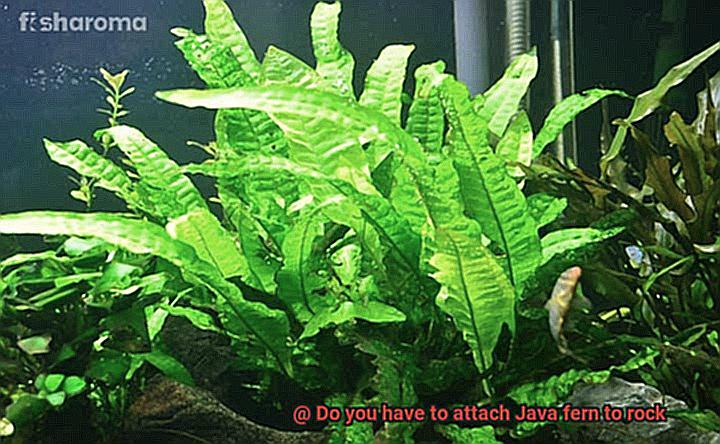
Disadvantages of Attaching Java Fern to Rock
If you’re contemplating attaching Java Fern to rock in your aquarium, it’s essential to be aware of the potential disadvantages that come with this attachment method. While it can undoubtedly enhance the natural beauty of your underwater world, there are a few drawbacks to consider. So, let’s dive into the risks and drawbacks associated with this method and explore alternative options for setting up your aquatic paradise.
One of the primary disadvantages of attaching Java Fern to rock is the time and effort it requires. This attachment method often demands additional materials such as glue or fishing line, which can be quite inconvenient for those seeking a low-maintenance plant option. Moreover, the process itself can be delicate and demands careful handling. If not executed correctly, you risk damaging or uprooting the plant, causing stress or even death.
Another drawback is that attaching Java Fern to rock can restrict its growth and spread. The roots of the plant may become constrained by the rock, preventing them from establishing a robust root system. Consequently, this hindrance can adversely affect the plant’s overall health and vitality.
Furthermore, rocks used for attachment may release minerals or chemicals into the water over time. This alteration in water chemistry can potentially harm other aquatic organisms in the tank. To mitigate this risk, it’s crucial to select aquarium-safe rocks and regularly monitor water parameters.
Once attached, repositioning or rearranging the plant becomes arduous. This limitation poses a problem if you desire to make changes to your tank layout or design. Detaching the plant from the rock can further stress it and disrupt its growth, making it an unfavorable option for those seeking flexibility in their aquarium setup.
Additionally, attaching Java Fern to rock may not always provide a natural aesthetic appearance in your aquarium. The visible presence of rocks and attachments can detract from the overall visual appeal, especially if you’re aiming for a more natural-looking underwater landscape.
It’s worth noting that attaching Java Fern to rock may not even be necessary. This resilient plant is renowned for its ability to attach itself naturally to various surfaces, including driftwood and other decorations in your aquarium. Allowing the plant to attach itself without human intervention often results in better growth and overall health.
Alternatives for Attaching Java Fern
Known for its resilience and stunning fronds, this aquatic plant is a favorite among aquarists. But how do you attach it to rocks or other surfaces in your tank? Fear not, we’ve got you covered with some fantastic alternatives.
- Fishing Line or Thread: A classic method that allows for easy removal or repositioning. Simply wrap fishing line or thread around the base of the Java fern and securely tie it to the rock. It’s a simple yet effective way to keep your fern in place.
- Plant Weights or Anchors: For a hands-off approach, plant weights or anchors are ideal. Attach these small metal pieces to the base of the Java fern and bury them in the substrate or secure them to a rock or driftwood. The weight holds the plant in place without any tying or gluing required.
- Suction Cups with Clips: Want a floating effect? Suction cups with clips are your go-to option. These handy tools provide a secure hold on the glass walls of your aquarium while allowing for easy removal when needed.
- Natural Attachment to Driftwood: For a more natural look, attach Java fern to driftwood. Over time, the roots will naturally attach themselves to the wood, providing a secure hold. Initially, use rubber bands or fishing line until the roots firmly grip the wood.
- Glue: If you’re after a permanent solution, glue is your friend. Use aquarium-safe glue designed for aquatic plants and fish. Follow instructions carefully and allow sufficient drying time before placing the plant back into the aquarium.
Growing Tips for Unattached Java Ferns
Look no further than the unattached Java fern. These floating wonders are not only visually appealing but also easy to care for. In this blog post, we will explore the best growing tips for unattached Java ferns and how you can create a stunning underwater landscape.
The Versatile Plant:
The unattached Java fern, also known as the floating Java fern, is a versatile plant that can be placed anywhere in your aquarium. Unlike other ferns, it doesn’t need to be attached to rocks or decorations. You can simply let it float freely in the water, adding a dynamic and natural look to your tank.
Lighting and Water Temperature:
To ensure the healthy growth of your unattached Java ferns, provide them with moderate to low lighting conditions. Avoid placing them directly under bright lights, as this can cause their leaves to burn or turn brown. Additionally, maintain a stable water temperature between 68°F and 82°F (20°C and 28°C) to keep your ferns happy and thriving.
No Special Substrate Needed:
Unattached Java ferns don’t require any special substrate or planting medium. You can place them directly in the aquarium without any attachments. However, it’s important to provide a gentle flow of water to ensure they receive adequate nutrients and oxygen.
Strategic Placement:
Get creative with the placement of your unattached Java ferns. They can be placed in various parts of the aquarium, such as the substrate, driftwood, or even floating near the surface. This allows for versatility in designing your aquarium layout and adds depth and dimension to your underwater paradise.
Regular Maintenance:
Regular water changes and maintenance are crucial for the healthy growth of unattached Java ferns. This helps prevent excess nutrient buildup and algae growth, keeping your ferns vibrant and beautiful. Additionally, monitor the health of your ferns regularly and look out for yellow or decaying leaves, which may indicate nutrient deficiencies or poor water conditions.
Fertilization if Needed:
While unattached Java ferns can extract nutrients from the water column, you can provide them with additional nourishment by using liquid plant fertilizers specifically formulated for aquarium plants. Follow the dosage instructions carefully to avoid overdosing and harming other aquatic life.
IlwLgUyRVpc” >
Conclusion
In conclusion, attaching Java fern to a rock is not necessary but can be beneficial for its growth and aesthetic appeal.
While Java fern is a hardy plant that can thrive when simply placed in the substrate or tied to driftwood, attaching it to a rock provides additional stability and prevents it from floating away. Moreover, the contrast between the lush green foliage of the Java fern and the rugged texture of the rock creates an eye-catching focal point in any aquarium or terrarium.
So, while it may not be mandatory to attach Java fern to a rock, doing so adds an extra touch of beauty and practicality to your aquatic or terrestrial setup.

